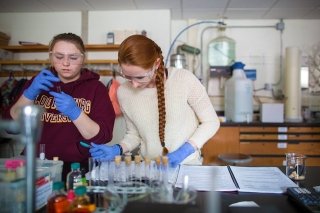CU-Bloomsburg Listed Among Best for Women in STEM for Chemistry
Bloomsburg
Posted

Commonwealth University-Bloomsburg has been listed among the “Best Colleges for Women in STEM” by Washington Monthly for chemistry.
Washington Monthly notes that women now make up about 60 percent of college students in the United States, but account for 39 percent of bachelor’s degrees in the fields of science, technology, engineering, and mathematics (STEM), according to the National Center for Education Statistics. As a result, women make up only a third of the workforce in STEM industries, including just 17 percent of engineers.
In the rankings, Washington Monthly ranked CU-Bloomsburg eighth in the nation for chemistry, noting that 63.6% of CU-Bloomsburg’s chemistry graduates are female and 59.2% of the percentage the campus’ student body is female. Median earnings for CU-Bloomsburg chemistry graduates five years after graduation is $55,473 annually.
“It is our honor to be ranked eighth in America’s Best Colleges for Women in STEM for Chemistry by Washington Monthly. This is thanks to our faculty serving as mentors and providing opportunities for women to succeed,” said Toni Bell, professor and chair of the Department of Physical and Environmental Sciences. “In 1996, I was the only woman in my graduating class of chemists at the University of Louisville. I was the first to successfully defend my dissertation and earn a Ph.D. in chemistry among mostly male peers in 2002. Now, I serve as department chair at a public university recognized for helping women succeed as chemists.”
Commonwealth University’s chemistry and biochemistry programs have garnered other accolades as well. Both programs are approved by the American Chemical Society (ACS). Students who complete certain requirements may then have their degrees certified by ACS. The biochemistry and pre-medicine concentrations are also accredited by the American Society for Biochemistry and Molecular Biology (ASBMB). Students in these concentrations can have their degree certified after completing the ASBMB exam. Additionally, students have opportunities to conduct undergraduate research directly with faculty mentors, which helps them earn acceptance in top graduate programs, medical and dental schools, and career positions.
Washington Monthly notes that “while most of the top-performing schools in our rankings are elite private colleges and flagship state universities, there are plenty of exceptions.” To create the rankings, the publication used data from the Integrated Postsecondary Education Data System to compare the gender distribution of every STEM program at 1,027 U.S. colleges and universities. The publication then ranked the 20 undergraduate programs with the highest and lowest percentage of recent graduates who are female in 10 popular STEM fields. More information about the rankings can be found at washingtonmonthly.com.



